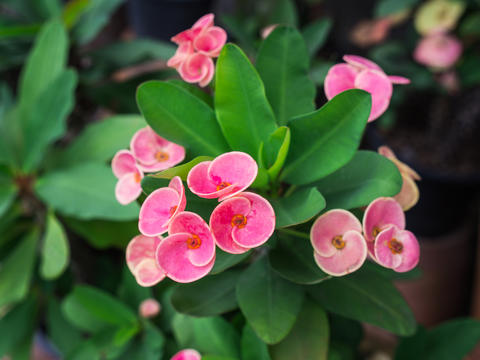Crown of Thorns
The Crown of Thorns is a popular species of spurge for the windowsill. The thorny, succulent plant with a biblical name adorns the home with its many colorful bracts.
Factsheet
- Growth type
-
- Small shrub
- Succulent
- Growth height (from)
- from 30 cm to 60 cm
- Growth width (from)
- from 30 cm to 60 cm
- Growth characteristics
-
- upright
- thorns or spines
- Flower color
-
- red
- pink
- white
- Flowering time (month)
-
- January to March
- October to December
- Flower shape
-
- unimpressive
- Flower characteristics
-
- unfilled
- hermaphroditic
- unimpressive
- Leaf color
-
- green
- page format
-
- elongated to ovoid
- round
- obovate
- Light
-
- sunny to scattered light
- Soil type
-
- gravelly to sandy
- Soil Moisture
-
- moderately dry to fresh
- ph value
-
- weakly alkaline to weakly acidic
- Lime compatibility
-
- lime-tolerant
- Nutrient requirements
-
- moderately nutritious
- Humus
-
- low humus
- Toxicity
-
- toxic
- Winter Hardness
-
- frost-sensitive
- Climate zones according to USDA
-
- 10
- Use
-
- Interior greening
- Planters
- Winter garden
- Warm House
- Garden style
-
- Pot garden
The Crown of Thorns (Euphorbia milii) is a species of spurge and a member of the family Euphorbiacea. It is native to the highlands of Madagascar. The extremely thorny flowering plant was first introduced to Europe in 1821. Its has the name "Crown of Thorns" because the houseplant’s thorny shoots are reminiscent of the crown of thorns worn by Jesus – however, due to the geographic isolation of the plants, it could not have actually been used for this. The plant was neither known nor widespread in Asia Minor 2000 years ago.
The shrubs grow upright to heights of up to 25 inches and form thick, thorny shoots that are sparsely branched and become woody over time.
Between the thorns are oppositely arranged, elongated rounded light green leaves. Handle the plant carefully: Besides the sharp thorns, you should also avoid direct skin contact with the poisonous milky white sap.
The petals are actually leaves that turn a reddish or white color. In botanical terms, they are known as bracts. The yellowish inflorescences of the Crown of Thorns are usually surrounded by two kidney-shaped bracts. They are very small and inconspicuous. The ends of the stems often have offshoots with further, smaller inflorescences.

The undemanding Crown of Thorns loves dry air and a bright, sunny location at normal room temperature, i.e. 65 to 75 degrees Fahrenheit. A south-facing window is an ideal spot for a houseplant that thrives in direct sunlight. The Crown of Thorns enjoys spending the summer in the garden. Thanks to its peculiar appearance, it goes well with cacti and other succulents such as Echeveria or Crassula. It also looks great alongside poinsettias. In winter, you should put Crown of Thorns somewhere with a temperature between 50 and 59 degrees Fahrenheit.
Permeable potting soils and cactus soil are good substrates for the Crown of Thorns. Make sure that the soil is rich in minerals.
As a succulent plant, the crown of thorns is fine with relatively little water. Always allow the surface of the soil to dry out before you think about watering. It needs even less water in winter. The plant drops its leaves during the winter rest period. However, the substrate should not be allowed to dry out completely, otherwise new growth may be significantly delayed in spring.
Fertilize the Crown of Thorns every two to three weeks between May and September with a normal dosage of liquid fertilizer or cactus fertilizer. The nutrients can simply be added to the plant’s water.
The Crown of Thorns grows relatively slowly and therefore only needs a new container every two to three years. As with most houseplants, it should be repotted in March towards the end of the winter rest period. The diameter of the new pot should be no more than two finger widths bigger than the old one.
Although the Crown of Thorns is tolerant of pruning, it is generally not necessary. However, should you need to prune it, wear gloves to protect yourself against the thorns and the poisonous milky sap. The shoots can be shortened throughout the year if required.
There are several subspecies and varieties with different growth heights, leaf lengths and thorn lengths; they are all native to Madagascar. However, most of these are only available from specialist plant stores. On the other hand, the subspecies Euphorbia milii var. splendens is quite common – it is by far the most widely available.
Euphorbia Lomii hybrids, a natural cross between Euphorbia milii and Euphorbia lophogona, is also relevant. They look very similar to the "true" Crown of Thorns, but retain their leaves in winter, grow more compact, branch well, and flower almost all year round in red, pink, or yellow.
You can propagate crown of thorns by seed. But the easiest option is to propagate it by cuttings: Take 2.75 to 3.93 inch long terminal cuttings in spring or summer. Dip the cut surfaces in lukewarm water to stop the flow of the milky sap. Leave the cuttings to air dry for one to two days and put them in a mix of potting soil and coarse sand (mixing ratio 1:1). The cuttings will form after approximately four weeks in a bright location with a temperature of around 72 degrees Fahrenheit .
The Crown of Thorns will drop its leaves if it is too cool, too dry, or kept in a drafty location. If the root ball is constantly wet, however, this can lead to root or stem rot and cause the entire plant to die. occasionally appear between the thorns. The Crown of Thorns is otherwise very robust.

